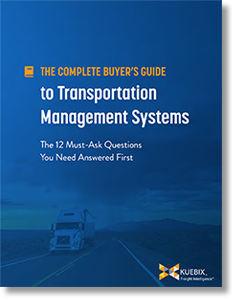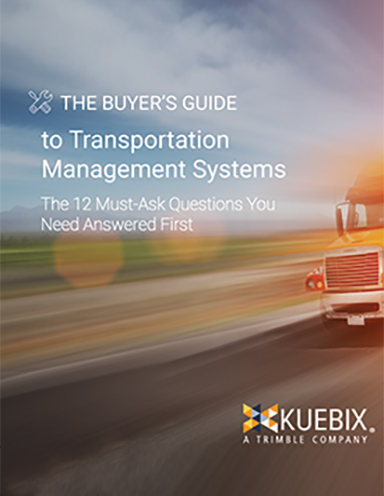What Is A Network-Based Supply Chain Platform?

Network-based platforms have been around for several years in the consumer space, but now, this methodology is being adopted in software-as-a-service, SaaS, and other cloud-based supply chain solutions that add value for users.
Network-Based Platforms
Every year there are new buzzwords about technology circulating the supply chain and logistics industries.
You probably see terms like blockchain, internet of things (IoT) and big data regularly take over your inbox.
The latest trend revolutionizing the software and technology space is Network-Based Platforms.
Network-based platforms have been around for several years in the consumer space, but now, this methodology is being adopted in SaaS and other cloud-based solutions to add value for users.
Network-Based Platform: Definition
A network-based platform is a piece of technology or software that connects users with other members of a community to create mutually beneficial opportunities.
Instead of simply being a tool to use within the four walls of an organization, network-based platforms help users find opportunities by connecting them with other users in the network while simultaneously fulfilling a function.
The usefulness of the platform snowballs as more and more members join the network. This phenomenon is known as the Network Effect.
What is the Network Effect?
The Network Effect exists when the addition of another person or company makes all the existing members of the network better off.
In a November 2014 video for UPS (watch the video above), MIT Professor Yossi Sheffi described the power and value of the network effect as follows:
“The network effect exists when the addition of another element [to the network] makes all the existing elements in the [network] better off,” explains Sheffi, citing cell phone networks and Facebook as examples.
“It’s a positive feedback loop. As the network grows, the more value it provides. The more value [the network] provides, it grows even bigger. It’s the economics of having an extra point on the network, and the fact that you can build a lot more services on the existing network, that’s the power of the network.”
Source: Talking Logistics
Therefore, to paraphrase Professor Sheffi;
“The network effect exists in transportation when the addition of another shipper, carrier, freight broker, or other participant to the network makes all the existing members of the network better off - by more quickly and efficiently matching demand with supply; by executing transactions in a more streamlined and automated way; and by providing everyone with network-based business intelligence and analytics about capacity, rates, on-time delivery, and other metrics.”
A network-based platform is a piece of technology that builds value by leveraging the network effect.
Examples of Network-Based Platforms
Social media – Network-based platforms have become incredibly popular, and very common, at a consumer level.
Social media sites like Facebook, LinkedIn, Twitter, Snapchat and Instagram rely on the network effect to retain users and scale their operations.
The more people who join the platform, the more valuable the platform is for everyone else.
Ride-sharing – Ride-sharing technology has also taken off thanks to the network-effect.
Companies like Uber and Lyft are based on a network of people looking for rides and people who can offer rides for a fee. This service isn’t merely a regular car rental, instead, these ride-sharing platforms connect thousands of individuals who otherwise would never have an opportunity to collaborate.
Fitness tech – The fitness industry has also incorporated the network effect into their technologies. Fitbit, for example, isn’t only a personal health monitoring device, it’s also a service to connect individuals with similar lifestyle goals.
Getting people to collaborate isn’t only an added social benefit for users, it can literally make the technology more effective for achieving fitness goals.
What’s the Difference Between Network-Based Platforms and Traditional Software?
Network-based platforms let users connect and collaborate with other stakeholders outside of the four walls of their offices or homes.
As more and more people become accustomed to network-based platforms like social media, companies are beginning to expect similar benefits from their business software.
Instead of simply managing day-to-day processes with technology, companies are demanding opportunities to collaborate with other stakeholders in their industry directly through the platforms they use every day.
In the transportation and logistics industry, a network-based transportation management system (TMS) allows users to collaborate with a vast shipping community for greater efficiencies such as accessing truckload spot quotes in addition to contracted carrier rates.
Unlike traditional platforms for managing logistics operations, a network-based TMS connects shippers with an entire ecosystem of other shippers, carriers, brokers, freight marketplaces and 3PLs.
The Network Transportation Management System (TMS)
Kuebix TMS is the only true Network Transportation Management System, TMS.
At Kuebix, we’re building the largest connected shipping community driven by our modular, cloud-based TMS that scales to meet the needs of small to enterprise companies.
Kuebix customers can manage all their modes and contracted carriers in Kuebix as well as take advantage of savings on truckload spot quotes, opportunities to fill fleet backhaul, and other discounts and benefits because they are part of our network.
That’s the Network Effect in transportation management at work!
Related Article: How to Choose the Right Transportation Management System for Your Company
Putting Community in TMS: Enabling the Network Effect in Transportation Management
In this eBook, Adrian Gonzalez, President, Adelante SCM in partnership with Kuebix TMS, describes how transportation management systems are transitioning from being “inside the four walls” applications to becoming operating systems that power transportation communities and enable network effects.
Transportation management systems are transitioning from being “inside the four walls” applications to becoming operating systems that power transportation communities and enable network effects.
Advancements in technology - most notably, cloud computing, software-as-a-service, application programming interfaces, and mobile computing - are making it easier for shippers, carriers, and brokers of all sizes, as well as private fleets and others in the transportation ecosystem, to more easily integrate and transact with one another.
The value-added benefits provided by network-based transportation management systems include smarter and faster freight capacity matching and the ability to leverage network-based business intelligence and analytics to discover and establish new business connections and to benchmark your transportation performance and metrics against the community as a whole.
Download the eBook Putting Community in TMS: Enabling the Network Effect in Transportation Management
Related Kuebix White Papers & eBook Resources
The Art of the Inbound: 11 Ways to Improve Your Inbound Shipping Operations
This ebook provides a guide to benchmark your company against best practices in the transportation and shipping industry and helps to put together a strategic approach to capitalizing on the opportunities to manage the “art of the inbound.” Download Now!
Driving Supplier, Carrier and Customer Collaboration
This ebook describes how through the use of collaboration portals with various stakeholders, you will be able to effectively manage your cost of goods and consistently meet the expectations of your internal and external customers. Download Now!
The Complete Buyer’s Guide to Transportation Management Systems
There is almost no limit to how a Transportation Management System can benefit your unique supply chain, but the key to success is finding the right one for your goals, so, before selecting a TMS, use the 12 questions in this buyer’s guide to finding the best solution for your company. Download Now!
Effectively Managing Big Data in Your Supply Chain
In this white paper, we’ll explain what the term “big data” means to the typical supply chain, introduce effective strategies for managing and leveraging that data, show how one grocer is using predictive analytics to harness its own big data, and explain the “first steps” that companies need to take down the path to effective management of their big data. Download Now!
More TMS content from Kuebix
Article Topics
Kuebix News & Resources
Visibility + TMS = A Winning Combination Trimble Placed in 2021 Gartner Magic Quadrant for Real-Time Transportation Visibility Platforms Kuebix Positioned Again as a Challenger in 2021 Gartner Magic Quadrant for TMS The Buyer’s Guide to Transportation Management Systems TMS Update: Adoption accelerates The Logistics of Valentine’s Day during COVID-19 Pandemic Research: Trends in the Supply Chain and Their Impact on the Transportation Management System Market More KuebixLatest in Transportation
Talking Supply Chain: Doomsday never arrives for Baltimore bridge collapse impacts Amazon Logistics’ Growth Shakes Up Shipping Industry in 2023 Nissan Channels Tesla With Its Latest Manufacturing Process Why are Diesel Prices Climbing Back Over $4 a Gallon? Luxury Car Brands in Limbo After Chinese Company Violates Labor Laws The Three Biggest Challenges Facing Shippers and Carriers in 2024 Supply Chain Stability Index: “Tremendous Improvement” in 2023 More Transportation




















